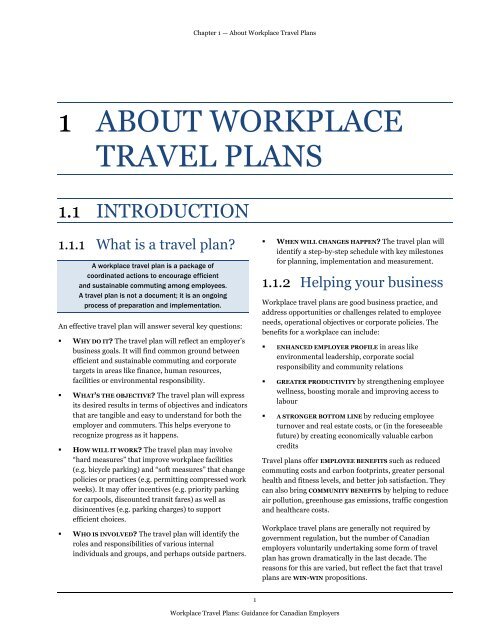Workplace Travel Plans - main body - Final Jan 2010 ENGLISH - FCM
Workplace Travel Plans - main body - Final Jan 2010 ENGLISH - FCM
Workplace Travel Plans - main body - Final Jan 2010 ENGLISH - FCM
Create successful ePaper yourself
Turn your PDF publications into a flip-book with our unique Google optimized e-Paper software.
Chapter 1 — About <strong>Workplace</strong> <strong>Travel</strong> <strong>Plans</strong><br />
1 ABOUT WORKPLACE<br />
TRAVEL PLANS<br />
1.1 INTRODUCTION<br />
1.1.1 What is a travel plan?<br />
A workplace travel plan is a package of<br />
coordinated actions to encourage efficient<br />
and sustainable commuting among employees.<br />
A travel plan is not a document; it is an ongoing<br />
process of preparation and implementation.<br />
An effective travel plan will answer several key questions:<br />
! WHY DO IT? The travel plan will reflect an employer’s<br />
business goals. It will find common ground between<br />
efficient and sustainable commuting and corporate<br />
targets in areas like finance, human resources,<br />
facilities or environmental responsibility.<br />
! WHAT’S THE OBJECTIVE? The travel plan will express<br />
its desired results in terms of objectives and indicators<br />
that are tangible and easy to understand for both the<br />
employer and commuters. This helps everyone to<br />
recognize progress as it happens.<br />
! HOW WILL IT WORK? The travel plan may involve<br />
“hard measures” that improve workplace facilities<br />
(e.g. bicycle parking) and “soft measures” that change<br />
policies or practices (e.g. permitting compressed work<br />
weeks). It may offer incentives (e.g. priority parking<br />
for carpools, discounted transit fares) as well as<br />
disincentives (e.g. parking charges) to support<br />
efficient choices.<br />
! WHO IS INVOLVED? The travel plan will identify the<br />
roles and responsibilities of various internal<br />
individuals and groups, and perhaps outside partners.<br />
! WHEN WILL CHANGES HAPPEN? The travel plan will<br />
identify a step-by-step schedule with key milestones<br />
for planning, implementation and measurement.<br />
1.1.2 Helping your business<br />
<strong>Workplace</strong> travel plans are good business practice, and<br />
address opportunities or challenges related to employee<br />
needs, operational objectives or corporate policies. The<br />
benefits for a workplace can include:<br />
! ENHANCED EMPLOYER PROFILE in areas like<br />
environmental leadership, corporate social<br />
responsibility and community relations<br />
! GREATER PRODUCTIVITY by strengthening employee<br />
wellness, boosting morale and improving access to<br />
labour<br />
! A STRONGER BOTTOM LINE by reducing employee<br />
turnover and real estate costs, or (in the foreseeable<br />
future) by creating economically valuable carbon<br />
credits<br />
<strong>Travel</strong> plans offer EMPLOYEE BENEFITS such as reduced<br />
commuting costs and carbon footprints, greater personal<br />
health and fitness levels, and better job satisfaction. They<br />
can also bring COMMUNITY BENEFITS by helping to reduce<br />
air pollution, greenhouse gas emissions, traffic congestion<br />
and healthcare costs.<br />
<strong>Workplace</strong> travel plans are generally not required by<br />
government regulation, but the number of Canadian<br />
employers voluntarily undertaking some form of travel<br />
plan has grown dramatically in the last decade. The<br />
reasons for this are varied, but reflect the fact that travel<br />
plans are WIN-WIN propositions.<br />
1<br />
<strong>Workplace</strong> <strong>Travel</strong> <strong>Plans</strong>: Guidance for Canadian Employers

















